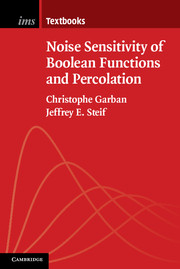Book contents
- Frontmatter
- Dedication
- Contents
- Preface
- Notations
- 1 Boolean functions and key concepts
- 2 Percolation in a nutshell
- 3 Sharp thresholds and the critical point for 2-d percolation
- 4 Fourier analysis of Boolean functions (first facts)
- 5 Hypercontractivity and its applications
- 6 First evidence of noise sensitivity of percolation
- 7 Anomalous fluctuations
- 8 Randomized algorithms and noise sensitivity
- 9 The spectral sample
- 10 Sharp noise sensitivity of percolation
- 11 Applications to dynamical percolation
- 12 For the connoisseur
- 13 Further directions and open problems
- References
- Index
Preface
Published online by Cambridge University Press: 18 December 2014
- Frontmatter
- Dedication
- Contents
- Preface
- Notations
- 1 Boolean functions and key concepts
- 2 Percolation in a nutshell
- 3 Sharp thresholds and the critical point for 2-d percolation
- 4 Fourier analysis of Boolean functions (first facts)
- 5 Hypercontractivity and its applications
- 6 First evidence of noise sensitivity of percolation
- 7 Anomalous fluctuations
- 8 Randomized algorithms and noise sensitivity
- 9 The spectral sample
- 10 Sharp noise sensitivity of percolation
- 11 Applications to dynamical percolation
- 12 For the connoisseur
- 13 Further directions and open problems
- References
- Index
Summary
The purpose of this book is to present a self-contained theory of Boolean functions through the prism of statistical physics. The material presented here was initially designed as a set of lecture notes for the 2010 Clay summer school, and we decided to maintain the informal style which, we hope, will make this book more reader friendly.
Before going into Chapter 1, where precise definitions and statements are given, we wish to describe in an informal manner what this book is about. Our main companion through the whole book will be what one calls a Boolean function. This is simply a function of the following type:
f: {0, 1}n → {0, 1}.
Traditionally, the study of Boolean functions arises more naturally in theoretical computer science and combinatorics. In fact, over the last 20 years, mainly thanks to the computer science community, a very rich structure has emerged concerning the properties of Boolean functions. The first part of this book (Chapters 1 to 5) is devoted to a description of some of the main achievements in this field. For example, a crucial result that has inspired much of the work presented here is the so-called KKL theorem (for Kahn–Kalai–Linial, 1989), which in essence says that any “reasonable” Boolean function has at least one variable that has a large influence on the outcome (namely at least Ω(logn/n)). See Theorem 1.14.
The second part of this book is devoted to the powerful use of Boolean functions in the context of statistical physics and in particular in percolation theory. It was recognized long ago that some of the striking properties that hold in great generality for Boolean functions have deep implications in statistical physics. For example, a version of the KKL theorem enables one to recover in an elegant manner the celebrated theorem of Kesten from 1980 that states that the critical point for percolation on ℤ2, pc(ℤ2), is 1/2.
- Type
- Chapter
- Information
- Noise Sensitivity of Boolean Functions and Percolation , pp. xi - xviPublisher: Cambridge University PressPrint publication year: 2014



